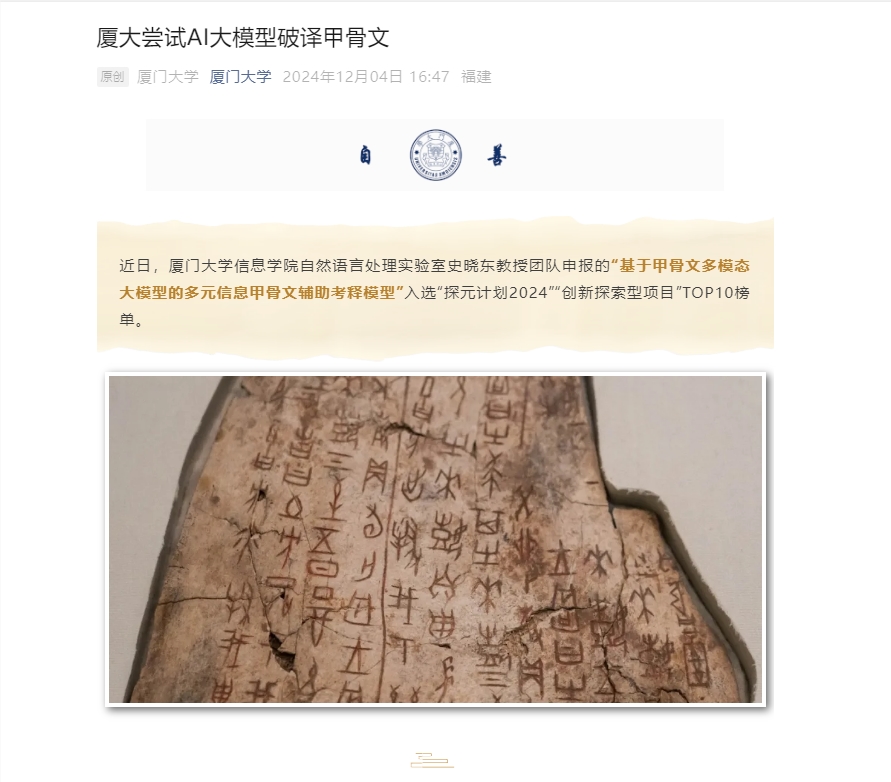The team of Professor Shi Xiaodong from the School of Information at Xiamen University stood out among the innovative exploratory projects of the "Exploration Plan 2024" and won the TOP10 award with its "Multiple Information Oracle Assisted Interpretation Model Based on Oracle Multimodal Large Model". This project uses artificial intelligence technology, especially deep learning models, to provide new ideas and technical means for deciphering Oracle, one of the four ancient characters in the world, marking the advancement of Oracle research into a new era of digitization and intelligence. This research will not only improve the efficiency of oracle bone inscriptions interpretation, but also make an important contribution to the inheritance and development of China's excellent traditional culture.
Recently, the "Multiple Information Oracle Auxiliary Interpretation Model Based on the Oracle Multimodal Large Model" by Professor Shi Xiaodong's team from the School of Information of Xiamen University was selected into the TOP10 list of innovative exploratory projects of the "Exploration Plan 2024", opening up a new path for the modern interpretation of Oracle .
Oracle bone inscriptions, as one of the four ancient characters in the world, have a history of more than 3,000 years and are the source of modern Chinese characters. However, traditional oracle bone inscriptions rely on manual interpretation by experts, which is cumbersome and time-consuming. Although methods such as glyph analysis and word example research are used, the interpretation process is still difficult. In recent years, the rise of artificial intelligence, especially deep learning models, has provided new ideas for auxiliary textual research on Oracle.

The "Multiple Information Oracle-Aided Interpretation Model Based on Oracle Multimodal Large Model" proposed by the Xiamen University team relies on the semantic representation capabilities of AI technology to systematically organize and build large-scale Oracle data sets, and uses cross-modal understanding capabilities to improve interpretation efficiency. The project designed a number of tasks and evaluation methods that are closely related to actual interpretation, including cross-font image mapping, cross-font IDS decoding, the translation relationship between oracle bone characters and modern characters, etc., aiming to effectively train multi-modality through these technical solutions Large model to assist in the interpretation of oracle bone inscriptions.
In addition, the project also designed an end-to-end comprehensive interpretation model that integrates pronunciation, form, meaning, and usage. It uses glyph structure, semantic association, homophones, and usage cluster analysis to develop a more portable interpretation system to adapt to limited resources. Practical application scenarios.
It is reported that the "Exploration Project 2024" was guided by the Department of Science and Technology Education of the State Administration of Cultural Heritage and launched in conjunction with a number of institutions to promote the protection of cultural relics and the development of digital technology. The project team of Xiamen University has successfully gained recognition with its years of deep cultivation and accumulation in the field of oracle bone inscription research. Professor Shi Xiaodong said that in the future, he will continue to optimize technology, promote the modernization of oracle bone inscription research, and help protect and inherit Chinese cultural heritage.
The successful selection of this project is not only an affirmation of the Xiamen University team’s many years of research results, but also indicates that artificial intelligence technology will play an increasingly important role in the field of cultural heritage protection, injecting new ideas into the inheritance and development of China’s excellent traditional culture. Vitality, it is expected to further enhance the efficiency and depth of Oracle research in the future.